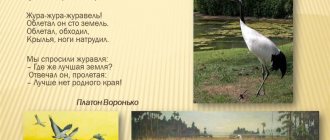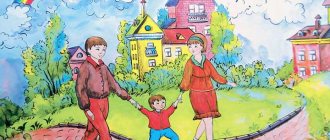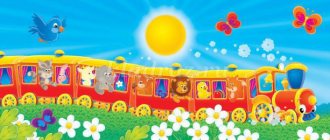Planning a thematic week “Visiting a Fairy Tale” in the middle group, taking into account the Federal State Educational Standard
Organization of developmental independent activities for children.
Place in - collections of fairy tales illustrated by different artists, illustrations, postcards depicting fairy tale heroes.
Didactic and printed board games on the topic. Puzzles, cut-out pictures, dominoes based on fairy tales. Masks, elements of costumes of fairy tale heroes; Paintings depicting plots and heroes of Russian folk tales, materials for creative works, reproductions of paintings based on Russian folk tales; Design of the exhibition of drawings “Heroes of Russian folk tales in my drawings”
Interaction with parents and social partners.
Involve parents in collecting a library of fairy tales.
Organize a competition for family works based on fairy tales.
Making a collage based on fairy tales.
Consultation “ Fairy tale therapy
in the life of preschool children”
Drawing up a recommended list of works of art for parents to read, watch, discuss together.
Types of children's activities
Contents and forms of work.
“A fairy tale has come to visit us.”
"Russian folk tales from a magic chest."
Goal: To help children understand what oral folk art is. Introduce the concepts of fairy tales, everyday tales, and tales about animals. Systematize knowledge about Russian folk tales.
“What is good and what is bad in fairy tales.”
Reading fiction
Miracles and transformations in fairy tales
Literary quiz
“In the Land of Fairy Tales” Purpose: to consolidate children’s knowledge about Russian folk tales.
To develop the ability to recognize fairy tales and their heroes. Develop interest in Russian folk art. Cultivate a love for books and respect for them. Excursion to the library “Where Fairy Tales Live”
Observation
on a walk, looking for the sun, looking at an inanimate object - looking at flowers in a flower bed, at passers-by, at insects.
Morning exercises
"Heroes of Fairy Tales"
Didactic games and exercises.
“Tell a story using a series of pictures”
“Find out the fairy tale from the illustrations.”
“Which fairy tales are mixed up” (group the characters by fairy tales).
“Who was here and forgot what?”
“What kind of fairy tale is this?” “What’s extra?”
Games to develop fine motor skills.
"Fairytale mosaic" Puzzles.
Gymnastics for the eyes.
Finger games based on folk tales.
Construction game
: “Fairy-tale palaces.” Goal: develop the ability to work with building materials, complement buildings with proportionate objects, and play with them.
Construction
"Figures of fairy-tale animals."
Consideration
illustrations for Russian folk tales
Modeling
"Grandmother's Tales"
«Illustration
to your favorite fairy tale." Continue working on using different art materials for drawing. Develop creativity, imagination, independence.
Exhibition of drawings
“Heroes of Russian folk tales in my drawings” We draw a fairy-tale city with crayons.
Application -
“Fairytale Bird”
Listening to songs and music from fairy tales and animated films. “The Wolf and the Fox”, “The Tale of the Golden Key or the Adventures of Pinocchio”.
Listening
songs and music from fairy tales and animated films. “The Wolf and the Fox”, “The Tale of the Golden Key or the Adventures of Pinocchio”.
Manual labor: “Repairing books”
Making a collage based on fairy tales
Final event:
Sports entertainment
“One, two, five and eight, we transport everyone into a fairy tale!”
Competition
of family works based on fairy tales, compiling a collage based on fairy tales.
Planning a theme week
To download materials from the site, you must log in to the site (log in with your username and password)
If you have not registered before, you can register. After authorization/registration on the site, you will be able to download the material necessary for your work.
Source
Lesson for children in the middle group of kindergarten: “Visiting a Fairy Tale”
Target:
Teach children to think creatively, solve riddles, and come up with a new ending for a fairy tale.
To promote the development of children’s ability, using means of expressiveness (intonation, facial expressions, gestures, characteristic movements, posture, gait), to convey not only the external features of the characters, but also their internal experiences, various emotional states, feelings, relationships, relationships between characters; teach yourself how to convey their behavior.
Expand children's language resources and phonemic awareness.
Develop logical thinking, memory, attention, creative imagination.
To foster the child’s independent thinking, activity, and perseverance.
Materials: bell, large Book of Fairy Tales, tabletop fairy tale theater “Kolobok”, other fairy tale characters, envelope, didactic game “Put Events in Order”
Progress of the lesson in the middle group
Educator: Children, let's say hello and wish each other a good mood. During the greeting poem, try to guess which Wonderland we will go to today!
Come on, everyone stand in a circle,
Smile sincerely at your friends!
Hold hands together
Gather your thoughts, everyone.
A fairy tale has come to us
And she brought riddles.
Educator: Well done, you guessed correctly. Today we will travel to the land of Fairy Tales.
Educator: A fairy tale is a land of dreams and fantasies. Just close your eyes and the fairy tale will take you into its magical world. The world of good and evil, love and hate, beauty and ugliness... The fairy tale will teach you to be strong, courageous, resourceful, hardworking and kind...
Educator: Children, do you like fairy tales? What fairy tales do you know? (Children's answers)
Educator: And the “Magic Book” will help us travel around the Land of Fairy Tales (the teacher shows the children the “Big Book of Fairy Tales”)
Educator: So, the journey begins... (teacher rings the bell)
Come on, your eyes are closing...
Let's go to the Land of Fairy Tales.
Book, book, hurry up,
Open the doors to the Fairy Tale!
Educator: Here we are in the Magic Land! But why doesn’t the Book of Fairy Tales open? Children, why do you think, what could have happened? (Children tell their versions)
Educator: I guessed, apparently, we need to guess the riddles that the Queen of Fairytale Land has prepared for us. (Children solve riddles, and the Magic Book opens to the desired fairy tale - answer)
Riddles about fairy tales
He ran away from Baba and Grandfather. I met different animals. And the little fox ate the naughty one right away and was like that! (“Kolobok”)
I’ll tell you, children, a fairy tale: about the Cat, about the Dog, and about Grandfather, and about Baba, and about the Mouse and Granddaughter. And if you remember all of them, you will guess the name of the fairy tale. ("Turnip")
A girl sits in a basket on a bear's strong back. Why did she hide there? I never confessed to anyone! ("Masha and the Bear")
He faked his voice. He began to sing in his mother’s voice and deceived the little children and ate him! What kind of fairy tale has come? Did the kids guess? ("The Wolf and the 7 Little Goats")
And so on.
Educator: Well done, you guessed all the riddles correctly! I wonder what the next page will be?
Educator: This is the “know-it-all” page. Now let’s check how well you know Russian folk tales:
— The Fox treated the Crane to... (what?)
- Who stole the Cockerel?
—Who did the straw bull bring to Baba and Grandfather?
- What did the Wolf say when he caught fish in the hole with his tail?
- Can a Hedgehog really outrun a Hare? How about in a fairy tale?
- What song did Kolobok sing to the Fox? What kind of fairy tale is this?
Educator: You are smart children, you know all the fairy tales! Now let’s turn the next page... Probably some surprise awaits us! Look how big the envelope is. What's in it? (Children look at the envelope and illustrations for the fairy tale)
Educator: It’s not clear what kind of fairy tale this is? Children, try to guess!
Exercise “Get events in order”
(children must put the pictures in the correct order and guess what fairy tale it is)
Educator: That's right, you guessed it - this is the fairy tale “Kolobok”. Let's remember the heroes of this fairy tale. Which of the heroes is good (evil, cunning, insecure, daring, timid). Why do you think so?
Educator: Children, do you think all the heroes of the fairy tale had the same mood? Let's try to show it (children convey the mood, emotions, movements of the characters).
— How concerned was Grandmother when she baked Kolobok?
- How happy was Kolobok Grandfather?
— What was Kolobok’s mood when he ran away from Baba and Grandfather?
- Show how Kolobok and Bunny (Wolf, Bear, Fox) met.
— Did the main character’s mood change throughout the fairy tale? How? Why?
- Sing Kolobok’s song, happy, sad, scared...
Educator: Children, remember how the fairy tale “Kolobok” ended? Do you like this ending? Let's try to remake it in a better and more instructive manner. (Children express their versions)
Educator: Well done, you did a great job. I think Kolobok will only be grateful to you, kids, his adventures ended so well!
Educator: Let's turn over another page of our Magic Book... Another surprise awaits us (the teacher shows the children the characters from the tabletop theater "Kolobok" and other fairy-tale characters: a pig, a cockerel, a cat, a goat, a dog...)
Educator: Let's try to come up with a new fairy tale about "Kolobok" and also with an interesting ending (children act out a table theater of the new fairy tale "Kolobok").
Educator: Well done! What a wonderful fairy tale we have created. Come up with a new name for it (“The Adventures of Kolobok”, “The Journey of Kolobok”, “How Kolobok Became Smart”, “Kolobok and the Cockerel”, “The Return of Kolobok”...)
Educator: Here is the last page of the Magic Book of Fairy Tales! Our journey has come to an end! Educator. Unfortunately, it’s time for us to return to kindergarten (rings the bell).
Eyes are closing...
And we go to kindergarten...
1-2-3
We have returned from the Fairy Tale.
Educator: And again we are in kindergarten. And in memory of our wonderful journey, I have prepared gifts for you - pictures of your favorite fairy-tale characters. Color them and together with your friends come up with many new, interesting fairy tales or stories.
Educator: Goodbye, children. And never forget that fairy tales are our friends. They live in our heart, in our soul, in our mind and imagination. Invent, fantasize - and the fairy tale will never leave you; will always be there, will delight and surprise you!
Thematic week “Visiting a fairy tale.” Senior group
Topic of the week: “The fairy tale is a lie, but there is a hint in it!
A lesson for a good fellow” for children 5-6 years old Description : this material will be of interest to teachers of senior and preparatory groups, primary school teachers, and mothers of many children. Goal : expanding children's knowledge about Russian folk tales Tasks: - to reveal to children the concepts of “fairy tale”, “folk tale”; - learn to tell fairy tales, retell them by role; — introduce the artist-illustrator of fairy tales Viktor Mikhailovich Vasnetsov; - promote the development of artistry, emotionality, through playing the role of a hero; — cultivate a love for the native language through reading and knowledge of Russian folk tales; - to cultivate an emotional perception of the content of a fairy tale.
MONDAY
Conversation “The fairy tale begins from the beginning, is read to the end, and is not interrupted in the middle”
Goal: teaching the rules of listening to a fairy tale.
Objectives: - clarify and consolidate the understanding of “fairy tale” as a work and as a term; - promote active listening from start to finish without interrupting; - promote the development of logical thinking; - contribute to the development of respect for the narrator, the speaker. Role-playing game: “Book Hospital”
Purpose: teaching to take care of books.
Objectives: - learn to “fix” a “sick” book; — continue to teach how to use scissors correctly and carefully glue; — promote the development of creative abilities; - contribute to the education of accuracy and thrift. Creative activity:
Drawing: “Alyonushka by the Pond” based on the painting by Viktor Mikhailovich Vasnetsov Modeling: “Little Goat”
Theatrical activity:
acting out mini-scenes based on a fairy tale
D/i:
“Which fairy tale is the hero from?”, “Guess the hero”
Art reading:
“ Sister Alyonushka and brother Ivanushka" (magical fairy tale) Reproduction of the painting: "Alyonushka" by Vasnetsov
Work with parents:
"My favorite book of fairy tales": children bring books from home and a mini-library or mini-store is compiled.
TUESDAY Conversation: “Folk tale - magical, about animals, everyday”
Goal: expanding the understanding of a folk tale.
Objectives: - give the concept of “folk”; - to develop knowledge about the division of fairy tales into three types: magical, about animals, everyday; — promote the development of children’s speech activity; — to promote interest in Russian folk art and pride in one’s people. Excursion to the library. Role-playing game “In the Library”
Goal: to introduce children to visiting the library Objectives: - to teach them to play the role of a librarian and reader, to conduct a competent dialogue;
- promote the development of artistry and creative activity; — to promote interest in the library as a home where books live. Creative activity:
Drawing: based on the fairy tale “Crane and Heron” Modeling: “Plate and Jug” Application: “Jug Decoration”
Theatrical activity:
acting out mini-scenes based on the fairy tale Goal: development of artistic abilities.
D/i:
“Describe the hero”
Fiction reading:
“The Crane and the Heron” (a fairy tale about animals) Examination of illustrations for the fairy tale.
Conversation: “Book illustration” Purpose: to familiarize yourself with the concept of “illustration” Work with parents:
please take your children to a bookstore.
WEDNESDAY Conversation “Heroes of fairy tales - what are they?”
Goal: expanding children's knowledge about the character of heroes.
Objectives: - learn to name the distinctive features of heroes, naming positive and negative qualities; - learn to describe actions and explain their meaning; – promote speech development and expansion of children’s vocabulary; - promote the development of correct behavior, a sense of compassion for the weak, and a desire to help. Role-playing game: “Bookstore”
Goal: developing children’s social experience through play activities.
Objectives: - teach how to properly conduct dialogue in a store; - learn to play the roles of seller and buyer; — promote the development of creative abilities; — promote a culture of behavior in the store. Creative activity:
Drawing: depiction of negative and positive characters Modeling: “Pot of Porridge” Application: “Golden Scallop Cockerel”
Theatrical activity:
acting out mini-scenes based on a fairy tale Goal: development of artistic abilities.
D/i:
printed board game “Tale by Tale”, “Which hero does the object belong to?”
Literary reading:
“Porridge from an Axe” (everyday fairy tale), “Flourish Hare”, “Cowardly Hare” and “Brave Hare”, etc.
THURSDAY Conversation “Vasnetsov - artist-illustrator of fairy tales”
Goal: introducing children to illustrators Tasks: - repeat the concept of “illustration”, “artist-illustrator”;
- give the concept of “reproduction”, “picture”; - learn to look at a picture and describe it; — promote the development of children’s speech activity; - promote interest in artistic creativity. Role-playing game: at the request of the children
Goal: development of children's creative activity
Creative activity:
Drawing: based on any of the selected fairy tales Modeling: based on any of the selected fairy tales Application: based on any of the selected fairy tales
Theatrical activity:
acting out mini-scenes based on the fairy tale Goal: development creative and artistic abilities of children.
Fiction reading to choose from:
“The Snow Maiden”, “Ivan Tsarevich and the Gray Wolf”, “Underground Kingdoms”.
Conversation “What do fairy tales teach?”
Goal: generalization and consolidation of acquired knowledge from fairy tales. Objectives: - learn to generalize acquired knowledge;
- promote the development of memory and observation; — to promote the cultivation of love for Russian folk art. Role-playing game: at the request of the children
Goal: development of children's creative activity
Creative activity:
Drawing: plot from a fairy tale to choose from.
Modeling: “Frog” Application: “Swans in the Pond” Theatrical activity:
acting out mini-scenes based on a fairy tale Goal: development of children’s creative and artistic abilities.
D/i:
“Guess the riddle”, assemble a picture from puzzles.
Fiction:
“The Frog Princess” Consideration of Vasnetsov’s reproduction. Throughout preschool age, children love to listen to fairy tales, retell them and write their own. Fairy tales in general contribute to the development of fantasy, imagination, creative thinking, make the child’s world magical, teach kindness and responsiveness, compassion and understanding. Read fairy tales more often! I hope my material will be interesting and useful to all those who work with children.
We recommend watching:
Thematic day in the preparatory group on the topic “Insects” Notes for a mathematics lesson in the senior group “Kolobok’s Journey” Notes on speech development in the senior group “Poultry” Thematic week “Wintering birds” in kindergarten. Second early age group
Similar articles:
Cultivating cognitive interest in social reality in children of senior preschool age



